In this article, we discuss twenty-seven (27) types of daisies briefly. Keep reading to learn more.
Daisies are attractive and aesthetic plants belonging to the Asteraceae family. This plant family is well known for its garden ornamentals, such as dahlias, marigolds, and chrysanthemums.
Plants in the daisy family are most recognizable due to the notable shape of their inflorescence and flower heads, which feature star, disc, or ray-shaped arrangements of petals and bracts. Daisies are found everywhere in the world except Antarctica.
Table of Contents
Symbolism
Daisies are symbolic in various ways. Blooming in spring, these charming flowers remind us of fresh starts, sunshine, and renewal.
In the language of flowers, daisies symbolize cheerfulness, love, beauty, purity, innocence, hope, fun and affection. During the Victorian Era, daisies were associated with innocence, loyalty and the capacity to keep secrets.
Daisies are also conventionally given to new mothers, because they symbolize childbirth, motherhood and new beginnings. In spirituality, daisies represent faith and eternal life.
Growth and Care of Daisies
Daisies are vibrant flowers that are easy to grow. They prefer rich, well-draining soil with an abundance of water, and sufficient sunshine.
Ideally, daisies flourish in soil that is neutral to slightly acidic, soil measuring 6.0 – 8.0 on the pH scale. Healthy soil means healthy roots for your daisies, so amend the soil in your garden before planting.
Use a mix of organic matter, including sand, peat moss and manure compost, to create an ideal growing environment for strong plants with elaborate blooms. Some daisy varieties may require staking to keep them upright.
Types of Daisies
1. African Daisy

- Botanical Name: Osteospermum spp.
- Other Names: Cape daisy, osteospermum
African daisies are a group of flowering plants native to South Africa. Their stunning and vibrant flowers come in a wide range of colors including shades of purple, pink, orange, yellow, and white.
Oftentimes, their centers are strikingly different from their petals, adding to their visual appeal. African daisies are favored selections for gardens, borders, and containers.
One remarkable quality of African daisies is their resilience to a variety of growing conditions. They prefer full exposure to sunlight but can also proliferate in relatively shaded areas, along with fast-draining soil.
They are able to survive periods of drought once established, making them well-suited for xeriscaping or locations with limited access to water.
African daisies are generally low-maintenance plants, necessitating frequent watering during dry spells and periodic removal of faded flowers to encourage continuous blooming.
They can be disseminated through seeds or by taking stem cuttings, and certain varieties may also propagate naturally through self-seeding.
2. Barberton Daisy
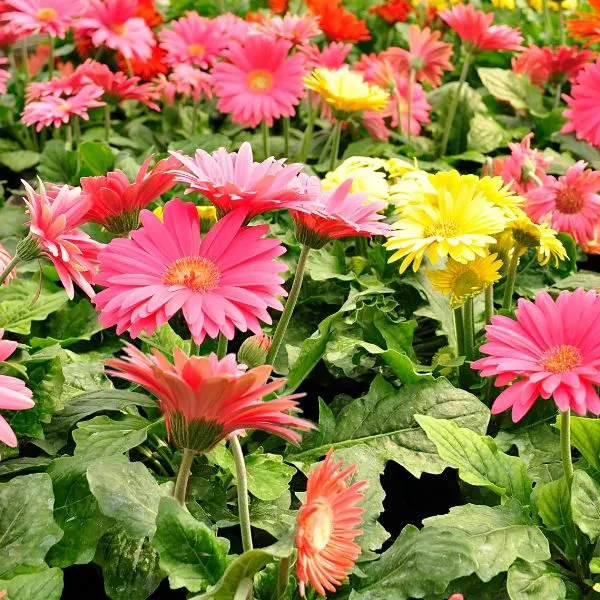
- Botanical Name: Gerbera jamesonii
- Other Names: Gerbera daisy, transvaal daisy
Barberton daisies are native to Southeastern Africa, and are commonly grown for their cheerful and bright flowers. They offer a broad spectrum of hues ranging from white to vivid red.
The large range of striking flower colors has enabled this flowering pot plant to become a popular house plant choice for a number of years.
Barberton daisies thrive in a position with full sun and sandy soil. A little compost added at planting will foster optimal flower growth.
A well-draining propagation mix and bright indirect light are compulsory. When nurtured indoors, they have the potential to bloom throughout the year. To promote new flower growth, remove withered flowers (this is known as deadheading).
Once all the flowers have faded, it is customary to either discard the Gerbera or place it in a greenhouse, in the hopes that it will produce blooms in the following year, although the likelihood of this happening is low.
3. Blue-Eyed Daisy
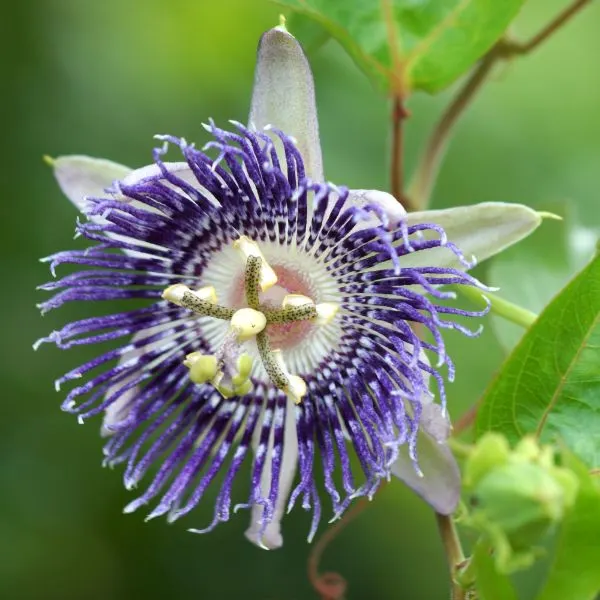
- Botanical Name: Arctotis stoechadifolia; Arctotis venusta
- Other Names: Blue-eyed African daisy, South African daisy, white Arctotis
Blue-eyed daisies are tender perennials native to South Africa. The flowers flaunt pearly white petals, and the center of each flower holds a powder blue eye surrounded by a yellow band.
Hybrids have petals in distinctive shades of blue, cream, orange, pink, purple, red, and yellow. The leaves are a dark green that substantially complements the flowers.They are best grown in mixed plantings with other summer-blooming annuals, or among perennials.
They are at home in cottage and children’s gardens, and they are often grown in cutting gardens. They prefer moderate watering and full sun conditions, but can also tolerate partial shade.
Blue-eyed daisies are ideal for containers; these containers must always have adequate drainage. They attract butterflies and beneficial insects, hence they are valuable in pollinator gardens.
4. Cape Marguerite Daisy
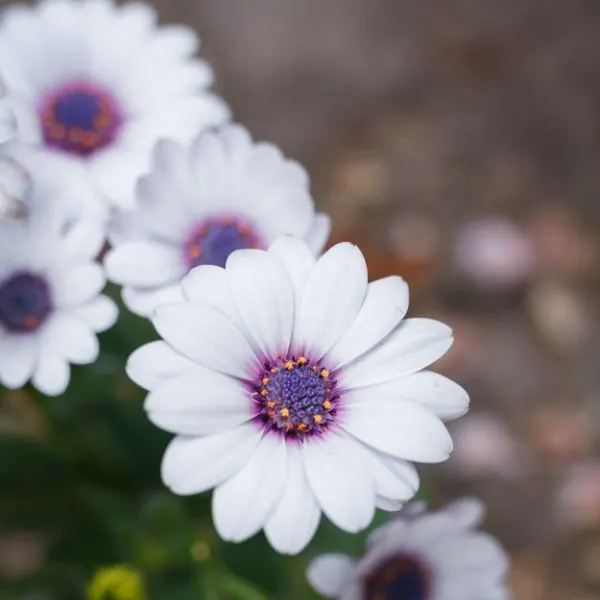
- Botanical Name: Dimorphotheca ecklonis; Osteospermum ecklonis
- Other Names: Blue-and-white daisy bush, star of the veldt, Sundays river daisy, Van Stadens river daisy, white daisy bush
Cape marguerite is a dainty perennial shrub that maintains its green foliage year-round. This charming plant features typical daisy-shaped flowers in either white or purple hues.
Cape marguerites are widely grown for their ornamental value in both containers and borders. They thrive with regular watering, preferring a balanced moisture level in the soil.
It is important to keep the soil consistently moist, but avoid overwatering, as excessive moisture can lead to the risk of root rot in these plants.
Once established, Cape marguerites are drought-tolerant, making them ideal for xeriscaping or low-water gardens, particularly in areas with dry climates. When planted in nutrient-rich soil, these daisies generally do not need fertilizer.
The delightful blooms of Cape marguerite daisies attract various pollinators, including bees, butterflies, and other beneficial insects, which can help promote biodiversity in your garden.
5. Cape Marigold

- Botanical Name: Dimorphotheca sinuata
- Other Names: Cape daisy, golden marigold, Namaqualand rain daisy
Cape marigold is an upstanding to spreading annual daisy native to South Africa, that boasts extraordinarily large orange or yellow blooms.
The flowers open to face the sun, but close on cloudy days or at sunset. The leaves are light green with slightly lobed margins, slender, and spoon-shaped.
Cape marigolds need well-drained, sandy soil and full sun. They require a moderate amount of water, and are able to withstand drought when established. They bloom in late winter to early spring.
Cape marigolds reseed and colonize large areas, creating a magnificent blanket of landscape color, even with only a small amount of water. Thus, they are relevant as a showy annual ground cover. They are good for containers and gardens.
6. Chocolate Daisy
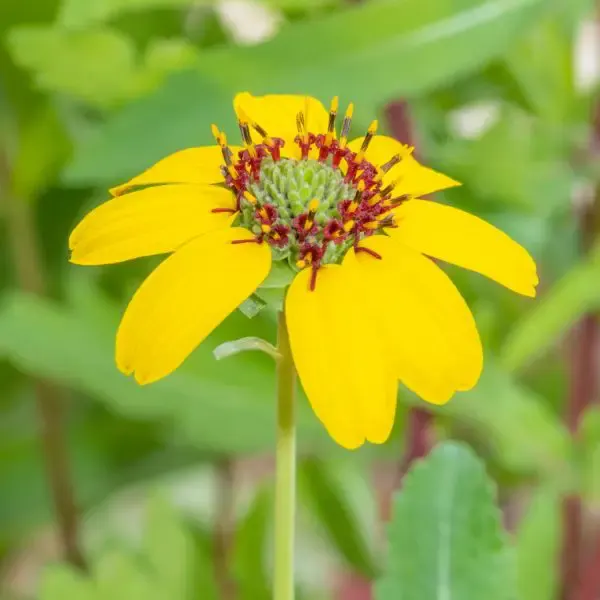
- Botanical Name: Berlandiera incisa, Berlandiera lyrata
- Other Names: Chocolate daisy, chocolate flower, green-eyed lyre leaf, lyreleaf greeneyes
Chocolate daisy is a delicate-looking, captivating and intriguing perennial wildflower with fragrant blooms that offer a chocolate aroma every morning.
It is indigenous to the southwestern regions of North America, compassing regions of the United States and Mexico. It features yellow petals adorned with brown markings at the base, resembling a center similar to chocolate.
Chocolate daisies flourish in well drained soil and exposure to full sun. They are drought tolerant and grow well in diverse soil types. They are relatively undemanding to maintain, making them an excellent addition to gardens, rockeries, or naturalistic landscapes.
The chocolate daisy is able to allure butterflies and other pollinators through its enchanting fragrance and nectar. It is a vital source of subsistence for these beneficial insects, while contributing to the ecosystem and fostering biodiversity.
7. Coneflower Daisy
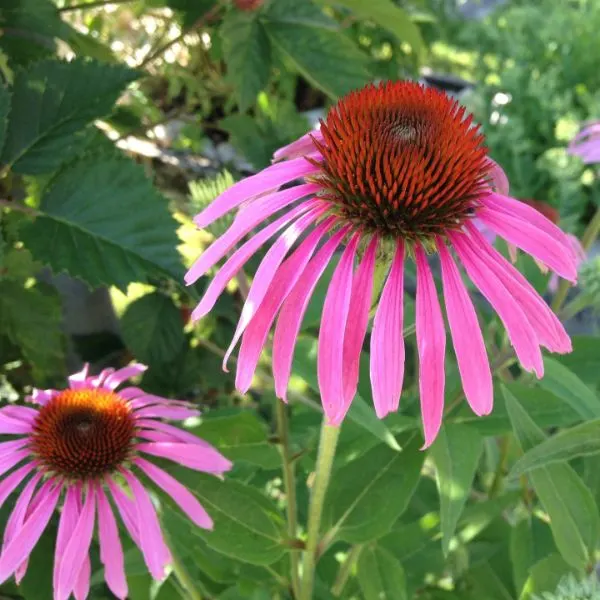
- Botanical Name: Echinacea purpurea, Echinacea spp.
- Other Names: Eastern purple coneflower, purple rudbeckia
Coneflower daisy is a perennial plant native to eastern and central North America, popular for its vibrant and cone-shaped flower heads. It is available in tones of pink, purple, white, and yellow.
The flower heads exhibit distinguished petals encircling an elevated central cone, typically displaying shades of dark brown or orange. This unique structure enhances visual interest.
Coneflowers are also known for their medicinal properties. They have been traditionally utilized in herbal remedies for their potential immune-boosting and anti-inflammatory effects.
Currently, Echinacea extracts and supplements are commonly employed as natural remedies to support immune health.
Coneflowers are relatively easy to cultivate and maintain. They prefer well-drained soil and full sun, although they can put up with partial shade. These hardy plants are drought-tolerant once established.
They serve as excellent additions to flower beds, borders, and prairie-style gardens, infusing vibrant colors, enticing pollinators, and attracting wildlife.
8. Crown Daisy
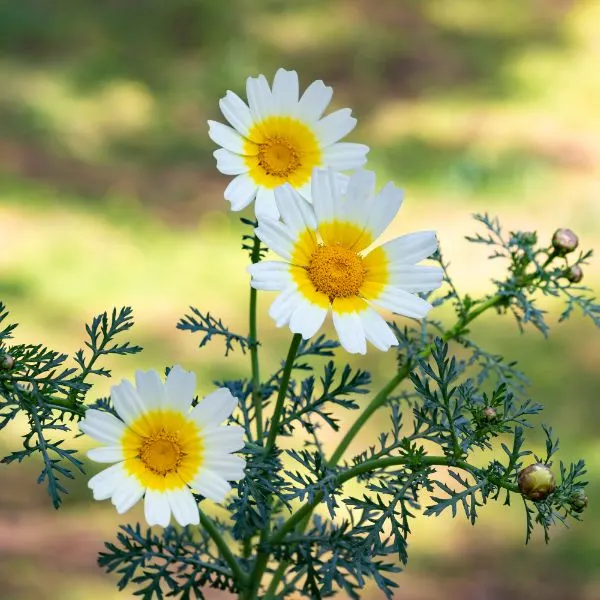
- Botanical Name: Glebionis coronaria (formerly Chrysanthemum coronarium)
- Other Names: Garland chrysanthemum, Japanese greens
Crown daisy is a native of the Mediterranean that has widely naturalized in Asia, where it is a popular leaf vegetable. Its Japanese name is shungiku, and its Chinese name is tong hao.
Unlike other daisies, crown daisy is not mainly cultivated as an ornamental for its flowers, but as an edible. The crown daisy features vivid golden flowers with distinctive fringed petals arranged in a daisy-esque formation.
They are typically harvested when still in their bud stage and used in various culinary dishes, particularly in Asian cuisine. The tender leaves of the crown daisy are entirely edible and can be consumed raw or cooked.
Once the Crown daisy has taken root, it is drought tolerant and can withstand dry spells admirably.
If you are planting from seedlings, it is advisable to maintain moist soil until they mature. Once mature, watering once a week is sufficient. It needs at least six hours of sunlight everyday.
Crown daisies can be propagated from seed. They are a multifunctional variety, highly valued for their culinary and ornamental uses. They are aesthetically pleasing, and add a touch of radiance and versatility to gardens and landscapes.
9. Dahlberg Daisy

- Botanical Name: Dyssodia tenuiloba, Thymophylla tenuiloba
- Other Names: Bristleleaf prickyleaf, golden dogwood, golden fleece, shooting star
Dahlberg daisy is an upright to sprawling ephemeral perennial, often grown as an annual. It is native to south-central Texas and northern Mexico, and can be found in hot areas from Texas to Florida.
This fragrant plant showcases an abundance of delicate daisy-like yellow blossoms in July and August. It proliferates in a variety of locations.
Dahlberg daisies are suitable for use as massed groundcover for low borders,in planters and hanging baskets. They are remarkably tolerant of dry conditions, and are not particularly fond of excessive rainfall or high humidity.
They perform best in full sun in dry to medium, well-drained soils. They require minimal pruning, and are generally immune to pests and diseases.
Maintaining Dahlberg daisies requires minimal, infrequent watering. They blossom without much attention, and readily propagate through self-seeding.
10. Damianita Daisy
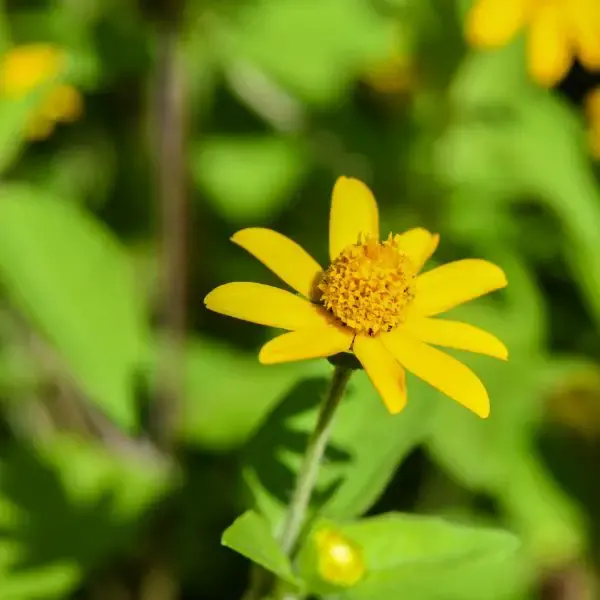
- Botanical Name: Chrysactinia mexicana
- Other Names: Calanca, false damiana, garanona, romerillo
Damianita daisies are compact evergreen shrubs native to Mexico, Texas and New Mexico. The first syllable of the genus name, ‘chrys’ means golden, which is indicatory of the bloom color.
From spring to September, they adorn themselves with vibrant yellow blossoms, creating a stunning display of color. Damianita daisies exhibit remarkable resistance to deer and drought.
Their growth rate is slow to moderate, and so it typically takes two or three years for them to reach maturity. They can thrive outdoors year-round, but the optimal time for planting is in the early fall.
Damianita daisies are hardy and easy to grow, requiring little more than abundant sunlight and careful pruning. They are dense plants and as such, they are excellent for mass plantings and in small spaces such as courtyards or along walkways.
They require full sun and are incredibly drought resistant. They tolerate most types of soil, but grow optimally in poor-quality soil that provides adequate drainage.
They are valuable for erosion control, border gardens, and ground cover for hot areas. Their bright, aromatic yellow flowers attract butterflies and other nectar pollinators throughout most of the year.
11. Desert Star Daisy
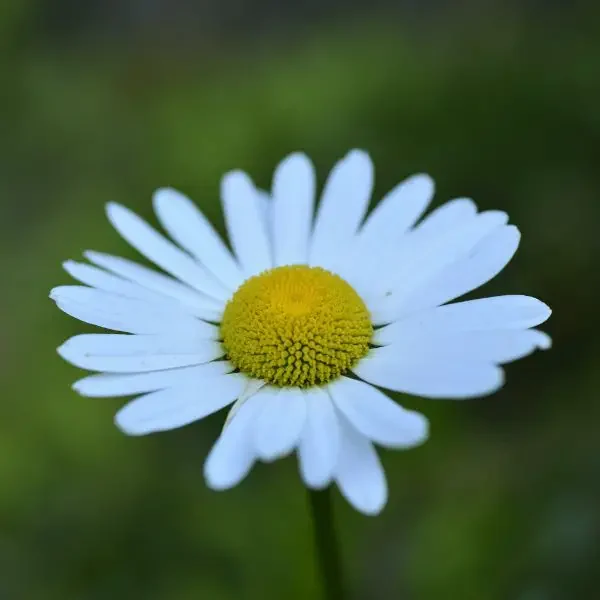
- Botanical Name: Monoptilon bellidiforme
- Other Name: Daisy desertstar
Desert Star daisy is a resilient perennial native to California and confined to western North America. It earns its name from its star-shaped flowers, which bloom abundantly in the springtime.
These flowers are typically white or pale pink, with delicate petals arranged in an exquisite star-like pattern. Desert star daisies grow optimally under full sun exposure and in well-drained soil.
They are commonly featured in desert gardens, rock gardens, and xeriscapes, where their compact growth and star-shaped blooms add visual appeal and intrigue to the landscape.
The desert star daisy has successfully adapted to harsh conditions by developing extensive root systems that enable it to access deep soil moisture reserves.
This adaptation renders it a resilient and self-sustaining plant capable of flourishing in arid landscapes. It is able to tolerate scorching heat and prolonged drought.
The desert star daisy not only enhances the aesthetics of desert landscapes but also serves as a valuable source of nectar for pollinators.
Its flowers act as a food source, attracting these beneficial insects and playing a vital role in supporting the overall ecosystem.
12. Engelmann’s Daisy
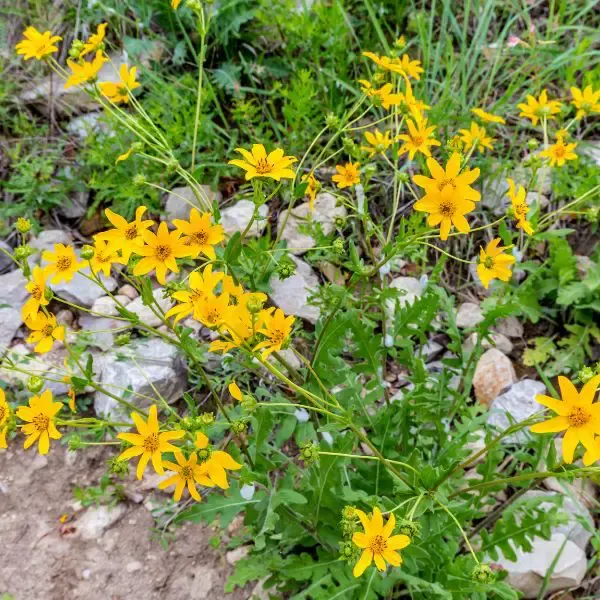
- Botanical Name: Engelmannia peristenia, Engelmannia pinnatifida
- Other Name: Cutleaf daisy
Engelmann’s daisy is a sturdy, showy evergreen perennial plant native to south-central North America. This hardy plant is resilient, and can be aptly described as “industrial strength.”
It displays an abundance of bright yellow daisy flowers and showcases ornamental rosettes of crisp and ruffled gray foliage that grace the plant for much of the summer.
Engelmann’s daisies prefer full sun or part to dappled shade for their growth. They thrive in calcareous loamy and clay soils, are highly drought-tolerant, and can stand up well to heat.
These features make them a suitable choice for rock gardens, xeriscapes, and other landscape settings where water availability may be limited.
Engelmann’s daisies are low-maintenance plants that necessitate minimal care once established in the soil. They are great for beds, borders, meadows and prairies.
Their vivid flowers provide a beneficial nectar source for pollinators, supporting the ecosystem and fostering wildlife conservation.
13. English Daisy
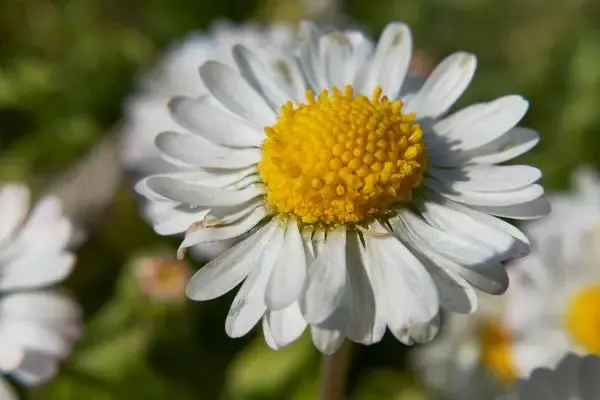
- Botanical Name: Bellis perennis
- Other Names: Common daisy, lawn daisy
The English daisy is a herbaceous perennial native to western, central and northern Europe.
Its flowers have a golden yellow disk in their core and are encircled by dainty petals of white, pink, or red. These petals fold up at night and open again with the sun.
English daisies burgeon in temperate climates with mild winters and cool summers, and are especially suited for cool seasons.
They blossom best in well-drained soil and full sun to partial shade. They prefer moist, loamy soil with good drainage. They are not drought-tolerant and need regular watering to stay in bloom.
Pruning and deadheading are not obligatory for English daisies and do not improve blooming. Regular watering is necessary, especially during dry periods, to keep the soil moist but not sodden.
Besides those that grow where they’re unwanted, their daily care is minimal, as they basically take care of themselves once established.
14. Felicia Daisy
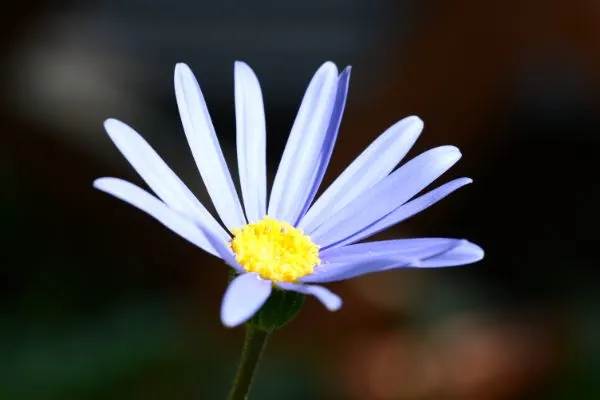
- Botanical Name: Felicia amelloides
- Other Names: Blue daisy, blue felicia bush, cape aster, kingfisher daisy
Felicia daisy is a low-growing bushy South African native perennial primarily cultivated for its long-lasting miniature blooms. Its flowers consist of showy sky-blue petals and bright yellow centers.
Felicia daisies revel in hot, dry climates and do not perform well in damp soil or humidity. They are easily grown in average well-drained soils in full sun, and are drought-resilient once established. They need only moderate water and little care to survive.
Felicia daisies propagate by seed or stem tip cuttings, and they require very little maintenance. They are excellent for pots and containers or in raised beds, dry walls, city gardens, cottage gardens, and rock gardens.
15. Florist’s Daisy
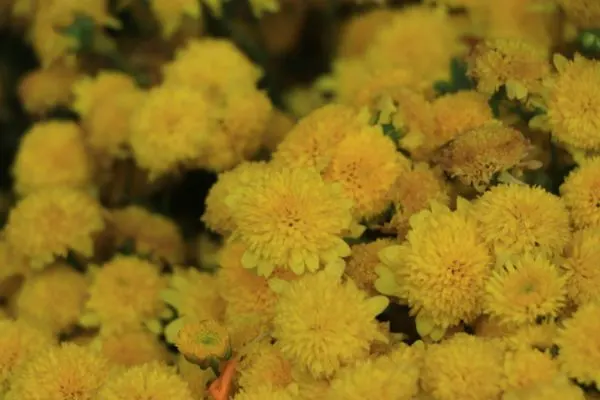
- Botanical Name: Chrysanthemum morifolium
- Other Names: Florist’s chrysanthemum, garden chrysanthemum, hardy garden mum
Florist’s daisy is a perennial autumn bloomer native to East Asia. It is popular for its beautiful and diverse array of flower forms and colors, including lavender, white, yellow, red and orange. Its leaves are serrated, fleshy, hairy, and smell strongly when squashed.
Florist’s daisies need well-drained soil and abundant, bright and direct sunlight for their growth. They can tolerate partial shade.
They require consistent watering to ensure optimal growth. It is important to keep the soil evenly moist, but not saturated, so that they do not develop root rot and other fungal diseases.
Florist’s daisies are valued in traditional medicine and herbal remedies. Certain cultivars are specifically selected for their aromatic properties and are used in the preparation of teas.
In many Asian cultures, they are closely linked with the fall season, and are used for decoration during festive occasions and celebrations.
16. Gaillardia Daisy

- Botanical Name: Gaillardia spp
- Other Names: Blanket flower, Indian blanket
Gaillardia daisies are short-lived color-popping perennials native to North and South America. They are particularly abundant in the central and western regions of the USA.
Their flower heads are made up of a central brown to dark red or maroon disk, surrounded by ray-like yellow, orange, or red petals.
Gaillardia daisies prosper in ample sun conditions. They prefer well-drained soil enriched with organic matter, and can adapt to different soil types, including sandy or loamy soil.
They do not like excessive moisture, and can develop root rot if cultivated in such conditions. It’s best to water them deeply but infrequently, and to allow the soil to dry out between waterings to prevent overwatering.
Gaillardia daisy is relatively resistant to drought conditions once established. During extended periods of drought or intense heat, it is advisable to provide additional watering to keep the daisies hydrated.
Gaillardia daisies are beneficial to pollinators. The nectar-rich flowers attract bees, butterflies, and other insects, contributing to the ecosystem and promoting biodiversity.
Their vibrant colors and long-lasting blooms make them a popular choice for adding color and beauty to flower beds, borders, and wildflower meadows.
17. Gloriosa Daisy
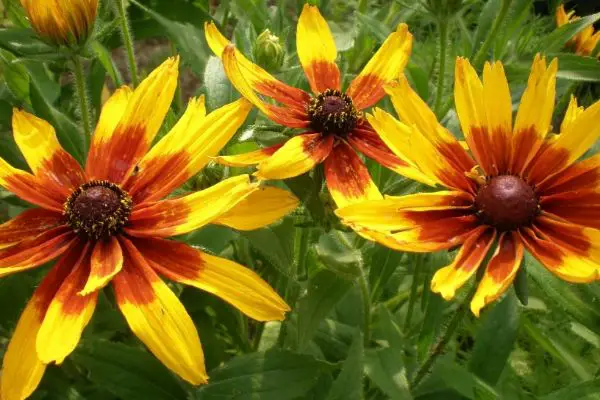
- Botanical Name: Rudbeckia hirta
- Other Names: Brown-eyed Susan, brown Betty, golden Jerusalem, yellow daisy
Gloriosa daisies are magnificent, upright annuals or short-lived perennials that hail from the moist meadows of North America.
Their large blooms are a rich golden orange or mahogany red that beautifully contrasts with their dark center, and they flower continuously through the hot summer months.
The Gloriosa daisy flourishes in full sun to partial shade, requiring at least 6 to 8 hours of direct sunlight per day. Although it prefers consistently moist soil, it is important to avoid overwatering.
It thrives in average, slightly heavy but well-drained soil. Regular irrigation is essential to keep the soil evenly moist, particularly during dry periods or hot weather.
The bright, showy and captivating flowers of the Gloriosa daisy are highly alluring to pollinators, including bees, butterflies, and other beneficial insects.
These nectar-rich blooms provide a valuable and nourishing food source for the pollinators, playing a vital role in supporting the ecosystem and fostering biodiversity.
18. Livingstone Daisy

- Botanical Name: Cleretum bellidiforme (formerly Dorotheanthus bellidiformis)
- Other Name: Buck bay vygie
Livingstone daisy is an annual flowering plant native to semi-desert areas of South Africa.
Its flowers display a stunning array of colors, including cream, crimson, orange, pink, white, and yellow. The iridescent petals make the blossoms shimmer in bright light. They close up at night and open during the day.
Livingstone daisies exhibit excellent tolerance to drought, and can adapt to salty and sandy soils. They thrive in full sun and well-drained soil. They require minimal watering once established, making them a suitable option for xeriscapes or water-wise gardens.
Due to its low-growing and spreading nature, livingstone daisy is frequently used as a ground cover or border plant. It can be grown in containers, hanging baskets, rock gardens, slopes, and hillsides.
Its ability to form dense, compact mats of foliage and flowers makes it an excellent choice for adding vibrant hues to gardens.
Livingstone daisies grow quickly and can reseed in hospitable spots. To encourage continuous blooming and maintain a neat appearance, it is best to regularly remove spent flowers by deadheading.
19. Marguerite Daisy
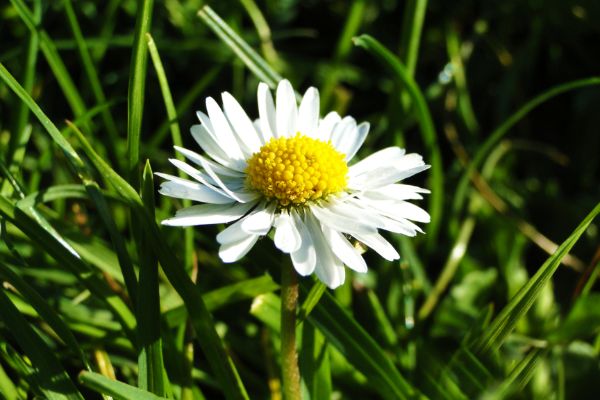
- Botanical Name: Argyranthemum frutescens
- Other Names: Canary Island daisy, Cobbitty daisy, golden marguerite, Paris daisy
Marguerite daisies are neat, unique little flowers native to the Canary Islands. They are highly revered for their charming and dainty flowers, beauty and simplicity.
Their petals provide an array of hues – typically white and pink surrounding a yellow center. There are also varieties available with other colors, including yellow, deep blue and purple.
Marguerites are often cultivated as garden plants, as they are somewhat easy to grow and sustain. They prefer full sun and well-draining soil.
They can be grown in garden beds, borders, or containers, adding a touch of pulchritude to any outdoor space. Deadheading depleted flowers can promote continuous blooming.
Marguerite daisies are esteemed for their capability to attract butterflies and bees, making them a beneficial option for pollinator gardens. They are known for their profuse and long-lasting blooms, which can last throughout the summer.
They are also suitable for cut flower arrangements, as their lovely blooms can brighten up indoor spaces.
20. Mexican Daisy
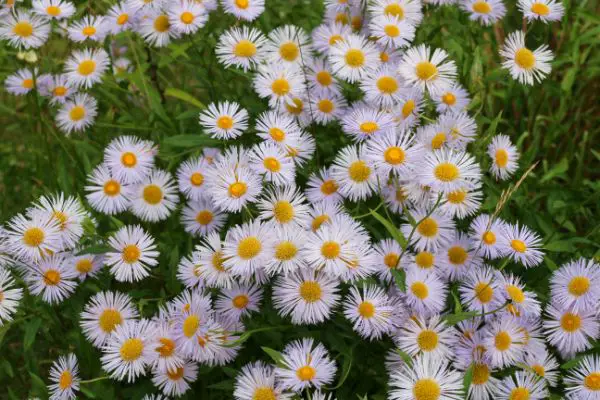
- Botanical Name: Erigeron karvinskianus
- Other Names: Dancing daisy, Latin American fleabane, Mexican fleabane, Santa Barbara daisy, seaside daisy
The Mexican Daisy is a mounding to sprawling perennial indigenous to Mexico and parts of central America.
Its flowers first emerge white in color, but soon turn soft pink and gradually transition to a deep magenta as they age, resulting in a visually stunning blend of colors. The profusion of flowers is highly appealing to butterflies and bees.
Mexican daisies prefer full sun to partial shade, but grow optimally under full sun exposure, in well-draining loamy soil.
Although they are drought-tolerant once established, they benefit from regular watering, especially during the summer months. It is important to keep the soil consistently moist during hot weather, but avoid overwatering.
Mexican daisies are toxic to cats, dogs and horses. They are virtually disease and pest free. They propagate by seed or through division.
Mexican daisies are ideal for a variety of locations, including beds and borders, containers, Mediterranean gardens, coastal gardens, rock gardens, and as ground cover.
21. Michaelmas Daisy
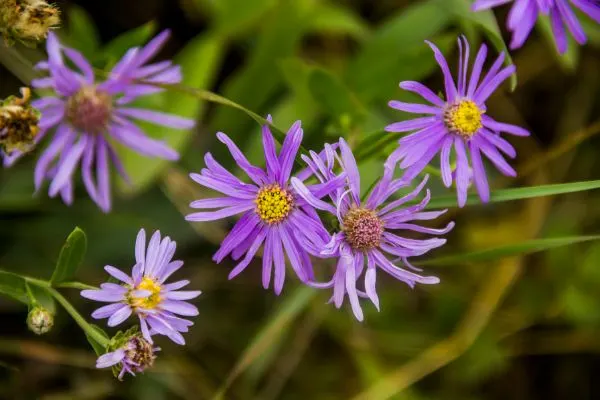
- Botanical Name: Aster amellus
- Other Name: Aster
Michaelmas daisies are charming perennials native to North America and Eurasia, recognized for their abundant flowers that bloom in late summer or early autumn.
The petals come in a variety of shades, mostly white, blue, deep purple, or pink. The central disks are golden yellow.
Michaelmas daisy thrives in fertile, quick-draining soil, in full sun or partial shade. It is resilient, relatively low-maintenance, and can tolerate a wide range of soil conditions.
It has moderate water requirements, and grows best in consistently moist soil. However, it is equally important to avoid excessive watering, as this can lead to root rot and other fungal diseases.
Michaelmas daisies are a favorite among pollinators, who are attracted to their nectar-rich flowers. To promote prolonged blooming and help maintain a neat appearance, deadheading of faded flowers is recommended.
They propagate by division in spring, and also from seed. They are excellent in garden borders, containers, and mass plantings.
22. Nippon Daisy
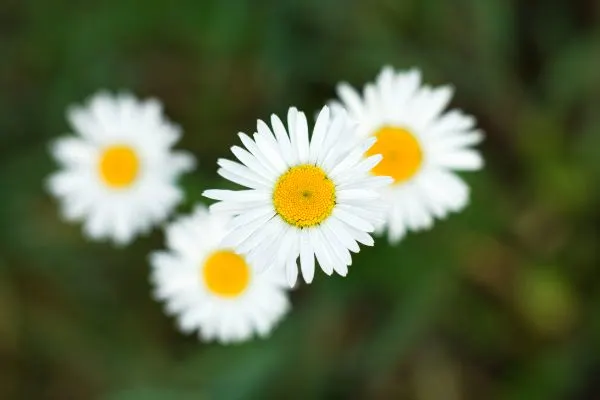
- Botanical Name: Nipponanthemum nipponicum
- Other Name: Montauk daisy
Nippon daisy is a herbaceous perennial flower indigenous to coastal regions of Japan and eastern Asia.
It is characterized by its striking, white flowers adorned with vibrant yellow centers. The flowers boast a plethora of petals that encircle a prominent disk, creating a beautiful and eye-catching display.
Nippon daisies thrive in well-drained soil and full sun, although they can tolerate light shade in hot climates. They are relatively low-maintenance and can adapt to different soil conditions, including sandy or rocky soils.
While it’s crucial to provide adequate watering during their establishment phase, they are drought-tolerant once established.
Nippon daisies are easy to propagate by lifting and dividing the root clumps. They tend to lose their lower leaves, so it is helpful to plant smaller perennials in front to cover up their leafless lower stems.
They are popular choices for gardens and landscapes due to their attractive flowers, long blooming period, and ability to withstand various growing conditions.
23. Oxeye Daisy

- Botanical Name: Leucanthemum vulgare
- Other Names: Common marguerite, dog daisy
Oxeye daisy is an invasive perennial wildflower, native to Europe and Asia. The attractive compound flower heads have several white ray flowers surrounding a bold goldish-yellow disk, resembling the eye of an ox.
Oxeye daisies flourish in average, well-draining soil, preferably in full sun. They can also grow in part sun or afternoon shade, especially in hot, humid climates.
Seeds should be consistently moist while they germinate; however, it is important to allow the soil to dry out between waterings.
Oxeye daisies typically bloom from late spring to summer, attracting pollinators with their nectar-rich flowers. After flowering, they produce seeds that can be dispersed by wind or animals.
These plants are often used in wildflower meadows or cottage gardens, and are best in controlled garden settings.
24. Painted Daisy
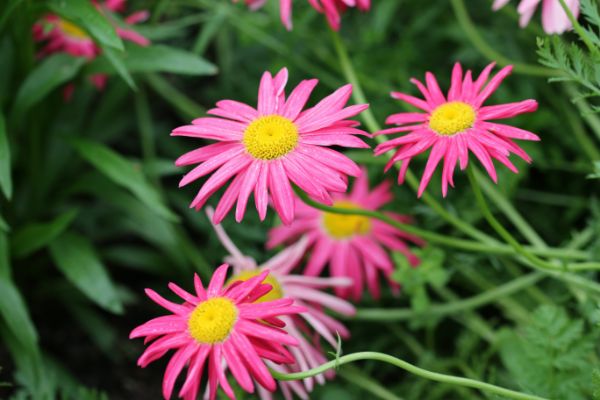
- Botanical Name: Tanacetum coccineum
- Other Names: Persian insect flower, pyrethrum daisy
Painted daisies are upright, bushy perennials native to southwestern Asia. They feature yellow centers enclosed by white, red, magenta, and marigold-colored petals.
They attract pollinators and are a natural insect repellent, making them excellent companion flowers in vegetable gardens.
Painted daisies are adaptable to various conditions. They grow best in well-drained soil and full sun, but can tolerate a range of soil types and partial shade. The soil should be kept moist but not soggy.
They are low-maintenance, generally hardy plants, and are suitable for temperate and cool climates. They are popular choices for borders, flower beds, and cottage-style gardens.
To promote growth, it is recommended to prune the daisies and deadhead spent blooms. Painted daisies propagate from stem cuttings or division.
25. Shasta Daisy
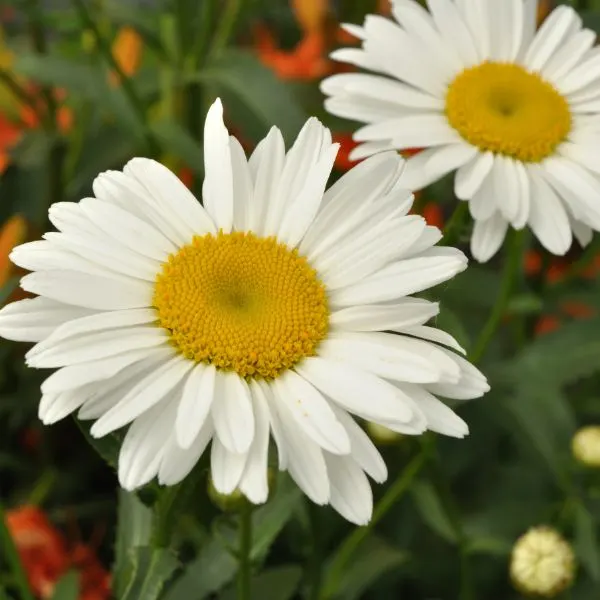
- Botanical Name: Leucanthemum x superbum
- Other Name: N/A
Shasta daisy is a hardy perennial flowering plant native to North America. It is a hybrid developed by crossing the oxeye daisy with several wild daisy varieties.
The flowers are popular for their multiple layers of cheerful white petals surrounding a prominent yellow center. They grow in clumps, and typically bloom from late spring to early summer.
Shasta daisies are relatively easy to grow and maintain and do not require much attention once established. They thrive in both full sun and partial shade, and can tolerate varying soil conditions, as long as it is well-draining.
Shastas require regular watering, especially during dry periods, to keep the soil consistently moist but not waterlogged. They are deer-resistant, drought-resistant, and generally not prone to many pests or diseases.
Shastas are popular choices for borders, flower beds, and cottage-esque gardens due to their alluring flowers and long blooming period. They are also beneficial for pollinator gardens, since they attract butterflies and bees.
26. Swan River Daisy
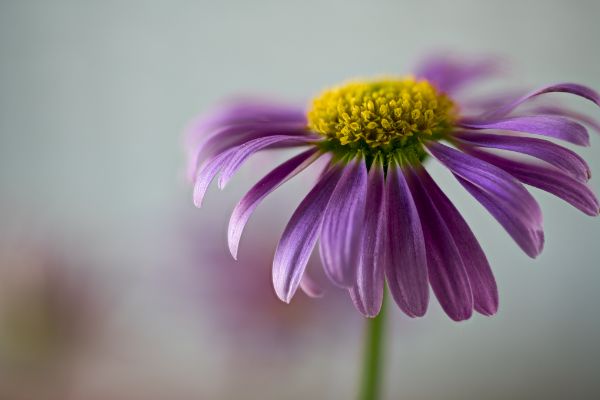
- Botanical Name: Brachyscome iberidifolia
- Other Name: N/A
Swan River daisy is a charming annual flower indigenous to Australia. It gets its name from the Swan River in Western Australia where it is commonly found.
It comes in a variety of colors: lavender, blue, pink, and white, with a center disk of yellow or black. It is known for its long blooming period.
For best results, Swan River daisies require full sun. They prefer rich, moist, well-draining soil, but can adapt to sandy and clay soils, particularly if they are amended with compost.
They are drought-tolerant and do not need much water; however, they have trouble blooming in overly hot and humid conditions. They do well as container plants, and are excellent choice for flower beds, borders and cut arrangements.
During the heat of the summer, it is recommended to trim the plant back to half its height. Deadheading is also beneficial during the flowering period. Swan River daisies can be propagated through cuttings.
27. Townsendia Daisy
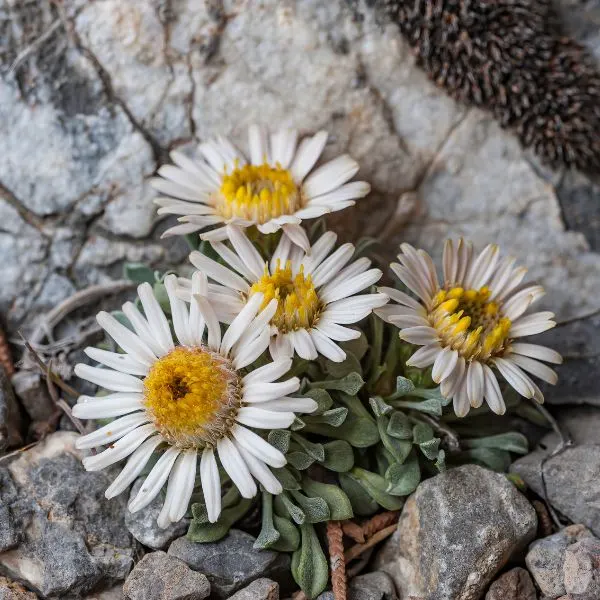
- Botanical Name: Townsendia spp.
- Other Names: Easter daisy, giant aster
Townsendia daisy is a short-lived perennial native to central and western North America. It is found in semi-desert areas, woodlands, foothills, and open areas.
It is characterized by small, delicate flowers which typically have white or pink petals surrounding a yellow center. The petals are often narrow and elongated, giving them a remarkable appearance.
Townsendia daisies prefer well-drained soil and are well-suited for rocky or sandy areas. They require full sun exposure, and they do not do well in areas of high humidity or heavy wet soils.
Once established, they are low-maintenance and can tolerate dry conditions. Regular watering may be needed during periods of prolonged drought.
Townsendia daisies can be found in various habitats such as prairies, open woodlands, and mountain slopes. They have adapted to withstand harsh conditions like drought and cold temperatures.
They are often used in rock gardens, borders, and wildflower meadows. They also attract pollinator insects, making them beneficial for the ecosystem.
Infographic of Different Types of Daisies
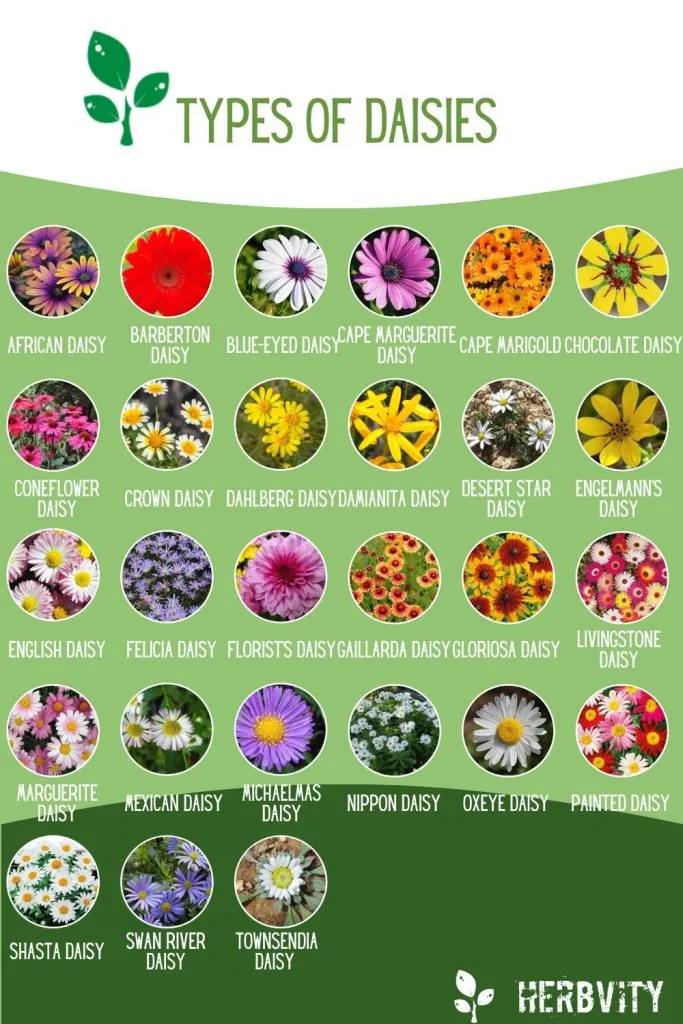
FAQs
Should I deadhead daisies?

Most daisies will have better blooms and new growth after deadheading. By deadheading regularly, you can enjoy their stunning blooms for longer.
What are some common disease problems of daisies?
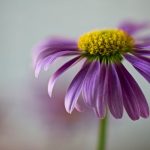
Common diseases affecting daisies include powdery mildew, leaf spot, rust, and botrytis blight. Regular inspection, good hygiene, and optimal conditions are important for disease prevention.
What are the easiest daisies to grow?
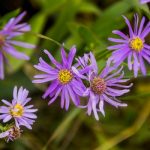
African, English, Oxeye, Painted, and Shasta daisies are some of the easiest daisies to grow because they can thrive in most garden conditions.
What are the most common pests affecting daisies?

Aphids, spider mites, thrips and whiteflies most frequently affect daisies.
What companion plants are recommended for daisies?
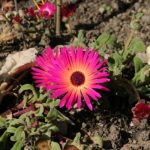
Recommended companion plants that grow well with daisies are: bellflower, blazing star (Liatris), crocosmia, garden gladiolus, hydrangea, lavender, lupine, petunia, Russian sage, and scarlet sage (Salvia).
What is the most popular type of daisy?
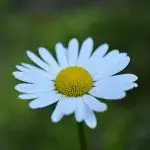
The most popular daisy types are Shasta daisies, Coneflowers, Gerbera daisies, African daisies, Marguerites, and Gloriosa daisies.
Conclusion
Daisies are visually appealing plants with vibrant colors and delicate petals that add loveliness to any setting, be it a garden, meadow or tabletop. Listed and explained above are twenty-seven (27) types of daisies.
Daisies go beyond aesthetics and create an atmosphere of charm and delight. They hold deep symbolic meanings and continue to enchant and inspire people, whether they are gifted or encountered in nature.
Daisies create a sense of natural splendor and tranquility, evoking feelings of serenity and bliss. They remind us of the inherent beauty around us and foster a connection to nature, uplifting the human spirit.
More plant stuff
